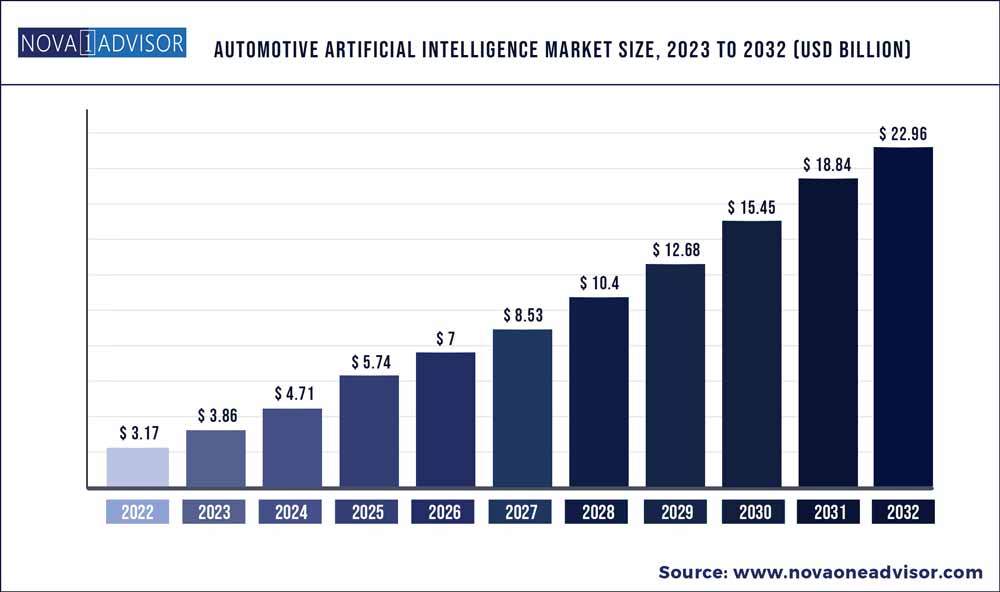The global automotive artificial intelligence market size was exhibited at USD 3.17 billion in 2022 and is projected to hit around USD 22.96 billion by 2032, growing at a CAGR of 21.9% during the forecast period 2023 to 2032.

Key Pointers:
- The hardware segment is projected to dominate the market with a share of over 59%.
- By application, the semi-autonomous segment held 54% revenue share in 2022
- By technology, computer vision segment accounted highest revenue share of over 35% in 2022.
- North America had the highest revenue share of above 39.4% in 2022.
- Asia Pacific is expected to witness a CAGR of more than 24.9% during the forecast period
Introducing (Artificial Intelligence) AI in the automotive industry ushers in a new era, allowing businesses to track operations, improve business plans, develop autonomous and semi-autonomous vehicles, and enhance digital outcomes. The global automotive AI industry is driven by the rising demand for autonomous vehicles, the adoption of artificial intelligence for traffic management, advanced automotive solutions, and government initiatives. Nevertheless, the absence of infrastructure, expensive procurement, and operational expenses remain obstacles to growth.
Artificial Intelligence (AI) in the automotive industry is driven by factors such as government initiatives to incorporate autonomous driving and the growing demand for autonomous vehicles. Furthermore, the automotive industry's expansion is likely to drive the artificial intelligence market’s growth. The automotive sector has benefitted from artificial intelligence and is one of the primary industries that use AI to augment and replicate human action.
The advent of standards such as Advanced Driver Assistance Systems (ADAS), blind-spot alert, Adaptive Cruise Control (ACC), and increased demand for convenience features continue to attract automotive providers to AI. AI mission-critical occurrences necessitate analysis, warnings, and directives. Automotive ADAS comprises various advanced sensors, such as LiDAR, Inertial Measurement Units (IMUs), radar, cameras, and pressure and temperature sensors for constant monitoring of surrounding conditions. The signal chain necessitates proper conditioning of sensor outputs, detection, and reliable low-latency communications within the vehicle and the surrounding infrastructure.
AI has enormous potential in the automobile industry when embedded within the industry's products, production, manufacturing processes, and value-added chains. AI deployment is expected to contribute significantly to a safer, cleaner, more efficient, and more reliable mobility ecosystem. For instance, AI applications in connected and automated vehicles improve driver safety, monitoring, situational awareness, comfort, and trajectory prediction. It can lead to significant gains in performance and efficiency, such as enhanced logistical flows, traffic fluidity, and reduced fuel or power consumption.
In recent years, businesses manufacturing Automated Driving Systems (ADS) technology have thoroughly live-tested autonomous vehicles operating in virtual environments to assure their dependability and safety. However, the COVID-19 pandemic, which began in March 2020, prevented, disrupted, and delayed the launch of these new product development test objectives due to its sudden beginning and continued resurgent impacts.
A study published by Adrian Chen Yang Tan on March 10, 2022, used data from the California Automated Vehicle Test Program to ascertain how the pandemic impacted testing trends, resumptions, and test conditions. The study emphasized how crucial it is for government measures to encourage and facilitate the development of autonomous vehicles in pandemic situations.
Automotive Artificial Intelligence Market Segmentation
| By Offering |
By Technology |
By Application |
By Process |
By Component |
|
Hardware
Software
Service
|
Computer Vision
Context Awareness
Deep Learning
Machine Learning
Natural Language Processing
|
Autonomous Driving
Human–Machine Interface
Semi-autonomous Driving
|
Signal Recognition
Image Recognition
Voice Recognition
Data Mining
|
Graphics processing unit (GPU)
Field Programmable Gate Array (FPGA)
Microprocessors (Incl. ASIC)
Image Sensors
Memory and Storage systems
Biometric Scanners
Others
|
Automotive Artificial Intelligence Market Key Players And Regions
| Companies Profiled |
Regions Covered |
|
Intel Corporation
Waymo, LLC.
IBM Corporation
Microsoft Corporation
Nvidia Corporation
Xilinx, Inc.
Micron Technology, Inc.
Tesla, Inc.
General Motors Company
Ford Motor Company
|
North America
Europe
Asia-Pacific
Latin America
Middle East & Africa (MEA)
|

